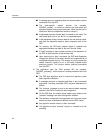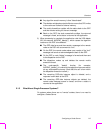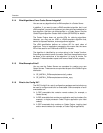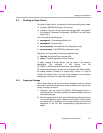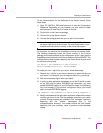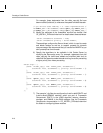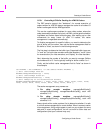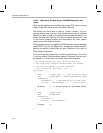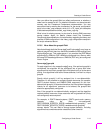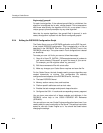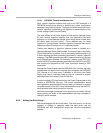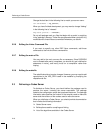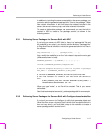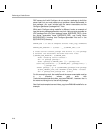
Creating a Codec Server
Configuring a Codec Server 2-11
2.2.3.1 Controlling I/O Buffer Caching for xDM 0.9 Codecs
The DSP server's support—the "skeletons"—for remote execution of
codecs written for xDM 0.9 always manages the cache for all codec I/O
buffers exchanged with the ARM application.
This can be a performance problem for some video codecs, where the
codec accesses the buffers exclusively via DMA, yet the generic skeleton
invalidates and flushes those buffers anyway, thus wasting up to a few
milliseconds for every frame. (In xDM 1.0 codecs, this cache
management is negotiated automatically.)
To disable management for specific buffers, you need to determine the
type of buffer and its number, then set the cache management field for
the buffer to "false", as shown in the following example.
The first step is to determine the buffer type. Supported buffer types are:
"in" and "out" for both video encoders and video decoders, "recon" (short
for reconstruction) for video encoders, and "display" for video decoders.
Next, determine the number of the buffer you want to manage. Buffers
are numbered 0 to 15. You're typically looking for buffer number 0 or 1.
Finally, set the buffer's cache management field to "false" as shown in
this example:
var H264ENC = xdc.loadModule( "ti.sdo.codecs.h264enc.H264ENC" );
// don't cache-manage inbuf #0:
H264ENC.manageInBufsCache[0] = false;
// don't cache-manage outbuf #1:
H264ENC.manageOutBufsCache[1] = false;
// don't manage any of the reconstruction buffers:
H264ENC.manageReconBufsCache = [ false, false, false, false, false, false, false,
false, false, false, false, false, false, false, false, false ];
The cache management array names are:
❏ For video encoder modules. manageInBufsCache[],
manageOutBufsCache[], manageReconBufsCache[], each with
elements 0..15.
❏ For video decoder modules. manageInBufsCache[],
manageOutBufsCache[], manageDisplayBufsCache[], each with
elements 0..15.
Always check with a codec producer first to determine whether it is safe
to turn off cache management for certain buffers. When it comes to cache
mis-management, things might appear to work on your system for some
data and in some configurations, but will not work for other data and
configurations (that your customer may use).




